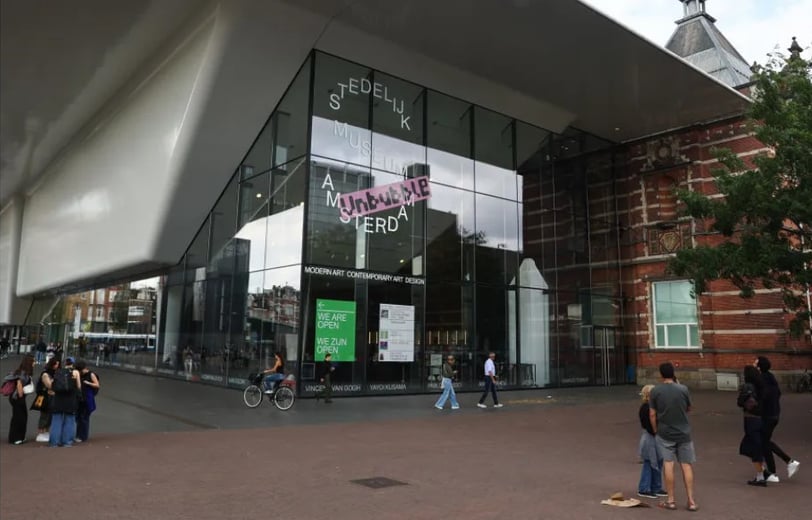Ahmet Öğüt Calls for the Stedelijk Museum to Halt Showing of 'Bakunin’s Barricade'
ARTE
11/6/20245 min read


Introduction to Ahmet Öğüt and 'Bakunin’s Barricade'
Ahmet Öğüt is a contemporary artist recognized for his innovative and politically charged oeuvre that critiques social norms and power structures. Born in 1981 in Diyarbakır, Turkey, he has gained international acclaim for his ability to intertwine art with activism, using thought-provoking installations to engage audiences in dialogue about pressing societal issues. His works often draw inspiration from historical events, infusing them with contemporary relevance, thereby highlighting the importance of cultural memory in the fight for justice.
One of Öğüt's notable installations is 'Bakunin’s Barricade,' a multifaceted piece that pays homage to the political theorist Mikhail Bakunin and the 1849 uprising in Dresden. The installation references Bakunin's ideas on anarchism, radicalism, and the inherent struggle against oppressive power. Through this artwork, Öğüt captures not only the physicality of a barricade but also its symbolic weight as a representation of resistance and defiance. The work features a collection of everyday materials that collectively form a structure resembling a blockade, encouraging viewers to reflect on the historical and ongoing struggles against authoritarianism.
'Bakunin’s Barricade' serves as both a literal and metaphorical platform for protest, inviting viewers to consider their roles in the fight for social change. Each element of the installation is carefully selected to resonate with themes of unity, communal action, and the desire for freedom. By drawing on the legacy of the Dresden uprising, Öğüt emphasizes the cyclical nature of revolution and the need for ongoing resistance against injustices in contemporary society.
This installation exemplifies how art can transcend traditional boundaries and engage with significant political narratives, cementing Ahmet Öğüt's position as a vital voice in contemporary art. As audiences interact with 'Bakunin’s Barricade,' they are prompted to reflect on their own histories of resistance, making the work a powerful commentary on the dynamics of protest and the quest for liberation.
The Stedelijk Museum's Role and Responsibilities
The Stedelijk Museum in Amsterdam holds a significant position within the contemporary art landscape, acting not only as a repository of artistic expression but also as a facilitator of dialogue surrounding pressing social issues. Established with the mission to engage the public through modern and contemporary art, the museum has a responsibility to thoughtfully curate its exhibitions, particularly those that engage with politically charged themes. In this context, displaying works like 'Bakunin’s Barricade' necessitates a careful consideration of the implications that arise from such art, especially when the artwork embodies a call to political action.
Historically, art has often served as a catalyst for social change, enabling artists and institutions alike to reflect societal conditions and provoke discussion surrounding them. Instances in which art intersects with activism reveal a complex relationship that museums must navigate. For example, exhibitions showcasing art that addresses issues of injustice or dissent can influence public sentiment and encourage activism. However, the ethical implications of exhibiting such works without a framework for real-world application raise questions about the museum's role as an enabler of change versus a static curator. The responsibility lies with the Stedelijk Museum to ensure that their exhibitions promote meaningful engagement rather than mere consumption of provocative art.
Furthermore, the Stedelijk must grapple with its institutional support for the artworks it displays. This includes evaluating whether these works are presented in ways that encourage audiences to engage critically with them and, ideally, to partake in the dialogues they provoke. Museums are not just galleries; they are platforms for discussion and potentially for action. As the Stedelijk Museum examines projects like 'Bakunin’s Barricade', determining how to appropriately engage with and contextualize such artworks is crucial for aligning with its mission in the modern sociopolitical landscape.
Calls for Action: Öğüt's Demands
Ahmet Öğüt, a prominent contemporary artist, is urging the Stedelijk Museum to halt its display of the installation titled 'Bakunin’s Barricade.' His request emerges amidst a climate of heightened social and political tensions, particularly in light of recent protests regarding Israel's military actions in Gaza. Öğüt's concern revolves around the museum's perceived misalignment in handling the installation, which is intended to provoke critical dialogues about resistance and oppression. He believes that the context in which the artwork is showcased is crucial to its interpretation and overall impact.
The timing of Öğüt's call for action is significant, as the ongoing conflict has reignited global discussions surrounding social justice, human rights, and the role of art in activism. 'Bakunin’s Barricade' was conceived as a commentary on societal struggles and the fight against authoritarianism. However, exhibiting it without addressing the complexities of the current political landscape raises questions about the museum's responsibility in facilitating meaningful discourse. Öğüt articulates that the artwork should serve as a catalyst for discussion and accountability, rather than becoming an object of aesthetic contemplation divorced from pressing social issues.
Öğüt's demands reflect a growing expectation among artists that their works contribute to larger movements for change and that art institutions recognize their role in these conversations. He emphasizes that the power of art lies not only in its visual language but also in its ability to engage audiences in critical examination of their surroundings. As the Stedelijk Museum navigates these complexities, it faces the imperative to consider how its programming intersects with pressing global issues and the expectations of the artists it represents. The call to action from Öğüt serves as a poignant reminder of the need for accountability and responsiveness in the realm of contemporary art.
Implications for Art and Activism
The recent call by Ahmet Öğüt for the Stedelijk Museum to cease the exhibition of 'Bakunin’s Barricade' has raised important questions regarding the intersection of art and activism. This incident underscores the evolving nature of political art and its reception in contemporary society, particularly within institutional frameworks. As art serves as a platform for discourse, the implications of this controversy extend beyond a single exhibition and reflect broader societal tensions.
One significant concern is how actions like Öğüt's influence the responsibilities of artists and institutions. As artists increasingly explore themes of social justice and activism, the expectations on museums to be receptive spaces for this dialogue grow. The controversy surrounding 'Bakunin’s Barricade' may lead institutions to reconsider their programming strategies and their engagement with politically charged works. Museums might find themselves in a precarious position, navigating the fine line between showcasing provocative art and addressing the potential discomfort it brings to various stakeholders.
Furthermore, this situation raises critical questions about the use of public space for protest. In a time where social movements frequently utilize art as a form of expression, the reactions from established institutions can shape the trajectory of artistic activism. The manner in which museums respond to these tensions could either foster a supportive environment for political expression or stifle dissenting voices. Artists may face repercussions, including censorship or alienation, which could deter them from pursuing bold, politically focused projects in the future.
Ultimately, this incident serves as a reflection of the complex dynamics between art and activism in the current cultural landscape. As societal issues continue to evolve, so too must the institutions that seek to represent them, ensuring that they remain relevant and responsive to the pressing concerns of our time.
